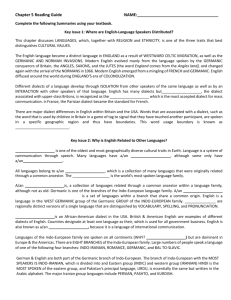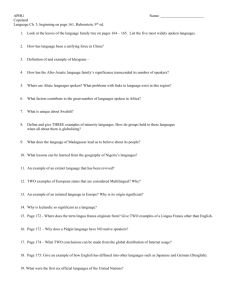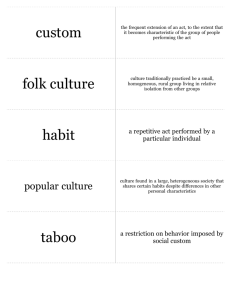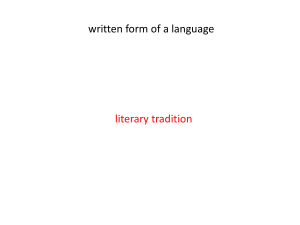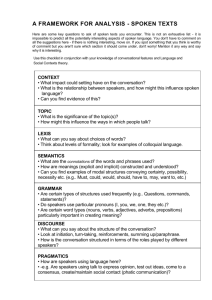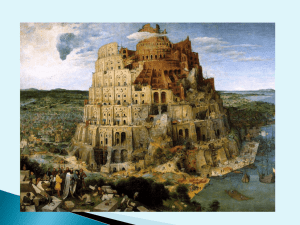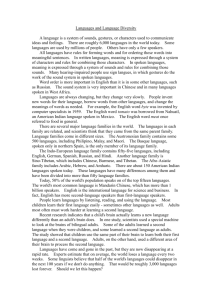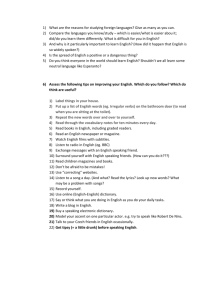Language Practice Multiple Choice Exam
advertisement
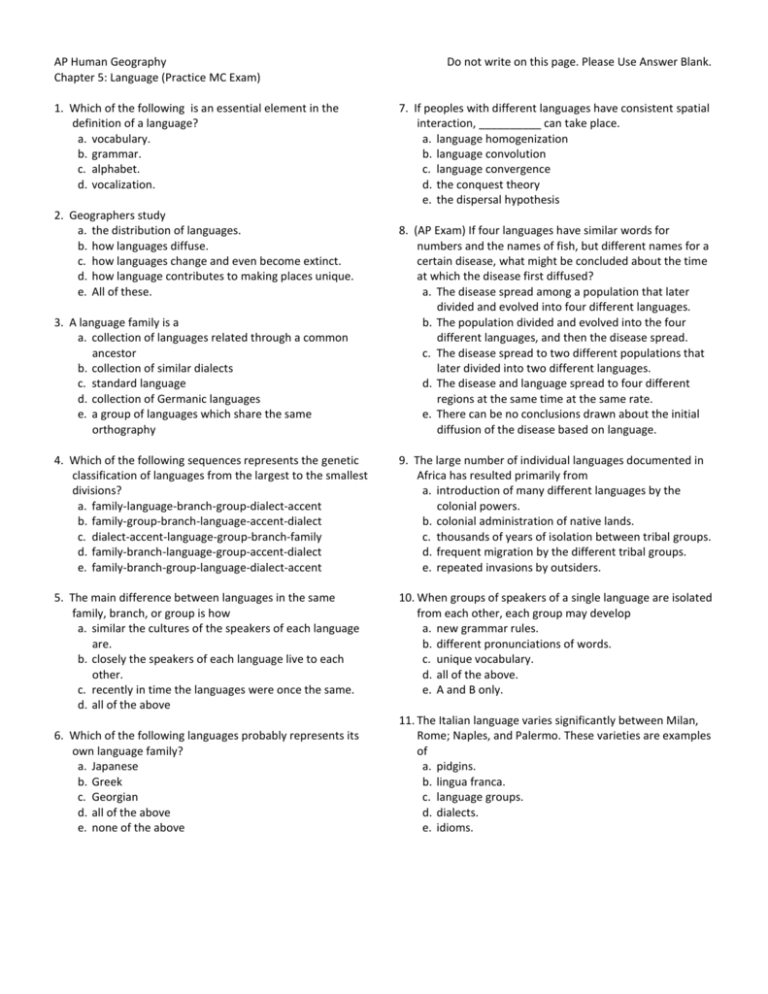
AP Human Geography Chapter 5: Language (Practice MC Exam) 1. Which of the following is an essential element in the definition of a language? a. vocabulary. b. grammar. c. alphabet. d. vocalization. 2. Geographers study a. the distribution of languages. b. how languages diffuse. c. how languages change and even become extinct. d. how language contributes to making places unique. e. All of these. Do not write on this page. Please Use Answer Blank. 7. If peoples with different languages have consistent spatial interaction, __________ can take place. a. language homogenization b. language convolution c. language convergence d. the conquest theory e. the dispersal hypothesis 3. A language family is a a. collection of languages related through a common ancestor b. collection of similar dialects c. standard language d. collection of Germanic languages e. a group of languages which share the same orthography 8. (AP Exam) If four languages have similar words for numbers and the names of fish, but different names for a certain disease, what might be concluded about the time at which the disease first diffused? a. The disease spread among a population that later divided and evolved into four different languages. b. The population divided and evolved into the four different languages, and then the disease spread. c. The disease spread to two different populations that later divided into two different languages. d. The disease and language spread to four different regions at the same time at the same rate. e. There can be no conclusions drawn about the initial diffusion of the disease based on language. 4. Which of the following sequences represents the genetic classification of languages from the largest to the smallest divisions? a. family-language-branch-group-dialect-accent b. family-group-branch-language-accent-dialect c. dialect-accent-language-group-branch-family d. family-branch-language-group-accent-dialect e. family-branch-group-language-dialect-accent 9. The large number of individual languages documented in Africa has resulted primarily from a. introduction of many different languages by the colonial powers. b. colonial administration of native lands. c. thousands of years of isolation between tribal groups. d. frequent migration by the different tribal groups. e. repeated invasions by outsiders. 5. The main difference between languages in the same family, branch, or group is how a. similar the cultures of the speakers of each language are. b. closely the speakers of each language live to each other. c. recently in time the languages were once the same. d. all of the above 10. When groups of speakers of a single language are isolated from each other, each group may develop a. new grammar rules. b. different pronunciations of words. c. unique vocabulary. d. all of the above. e. A and B only. 6. Which of the following languages probably represents its own language family? a. Japanese b. Greek c. Georgian d. all of the above e. none of the above 11. The Italian language varies significantly between Milan, Rome; Naples, and Palermo. These varieties are examples of a. pidgins. b. lingua franca. c. language groups. d. dialects. e. idioms. 12. Which of the following pairs of languages are not mutually intelligible? a. Urdu and Hindi b. Danish and Norwegian c. Serbian and Croatian d. German and Dutch 13. A pidgin language a. has a limited vocabulary. b. has few, if any, grammar rules. c. is a simplified language based on two separate languages. d. is not the first language of any person. e. all of the above. 14. A pidgin language a. stems from folk culture. b. is spread by popular culture. c. has no native speakers. d. all of the above e. none of the above 19. Latin octo (eight) became Italian otto, Spanish ocho, and French huit. This is an example of ____________ over time in a language family. a. deterioration b. sound shift c. dialect development d. isogloss shift 20. The geographic study of the distribution of languages provides a good example of a. the interplay between globalization and local diversity. b. the role and spread of religion across much of the world. c. political conflicts that arise due to ethnic tensions. d. the diffusion of folk culture in different areas of the world. 15. Convergence processes yielding a synthesis of several languages produce a pidgin language. When this language becomes the first language of a population it is referred to as a a. dialect b. Creole language c. language subfamily d. lingua franca e. corrupted language 16. When Dutch traders and Japanese traders meet, they often use English to conduct their business transactions. This use of English is an example of a(n) a. b. c. d. e. pidgin language creole language official language lingua franca monolingualism 17. Vernacular language a. is spoken mostly by the lower class. b. has become synonymous with less education. c. has relaxed grammar rules. d. is dynamic and always changing. e. all of the above. 18. The geographical boundary between the linguistic use of pail and bucket is called __________ a. a linguistic break. b. a fault line. c. a dialect intrusion. d. an isoline. e. an isogloss. Answer questions 21-25 based on the map above in which language families are marked as shaded areas. 21. Altaic is shaded area a. A b. B c. C d. D 22. Dravidian is shaded area a. A b. B c. C d. D 23. Amerindian is shaded area a. A b. B c. C d. D 24. Niger-Congo is shaded area a. A b. B c. C d. D 25. Guarani and Quechua are important languages in which family shaded on the map? a. A b. B c. C d. D 26. Which of the following language families became widely dispersed due to trans-oceanic migrations? I. Uralic II. Indo-European III. Sino-Tibetan IV. Austronesian a. I and II b. III and IV c. I and III d. II and IV e. II, III, and IV 27. The second-largest language family is a. Afro-Asiatic. b. Indo-European. c. Dravidian. d. Sino-Tibetan. e. Austronesian. 28. Russian is part of what language branch? a. Indo-Iranian b. Altaic c. Romance d. Balto-Slavic e. Germanic 29. (AP Exam) Which of the following areas has the greatest linguistic fragmentation? a. Korea b. Scandinavia c. Caucasus d. Argentina e. Quebec 30. From the list below, choose the country with the most languages spoken. a. China b. Brazil c. India d. Pakistan e. Canada 31. Which regions have the most and fewest languages that are under threat of extinction? a. Most: Asia; Fewest: The Americas b. Most: Africa; Fewest: Europe c. Most: The Pacific; Fewest: Asia d. Most: The Americas; Fewest: Europe e. Most: Africa; Fewest: The Pacific 32. Which of the following is true about language extinctions? a. They happen suddenly and without warning. b. They are usually the result of genocide. c. There could be several thousand over the next century. d. They are increasingly rare. e. They are unrelated to cultural imperialism. 33. Which is the world's primary lingua franca language? a. Mandarin Chinese b. Russian c. English d. Spanish e. Hindi 34. The extinction of many languages once spoken in Peru is a result of a. chain migration b. relocation diffusion c. political dominance and conversion d. contagious diffusion e. popular culture revival 35. Which of the following statements, regarding the number of languages, is true? a. There are fewer languages spoken today than there were 1000 years ago. b. Due to creolization, there are more languages spoken today than at any time before. c. Languages increasingly use divergent orthographies. d. Due to widespread illiteracy, most people today speak dying languages. e. Due to interest in reviving dead languages, new languages are spoken every year. 36. Acculturation is a common cause of a. illiteracy. b. language extinction. c. assimilation. d. creolization. e. cultural diffusion. 37. According to acculturation, how many generations on average does it take for an immigrant family to lose its primary language? a. One generation b. Two generations c. Three generations d. Four generations e. They never lose their primary language. 38. Globalization is __________ the world's linguistic heritage. a. not affecting b. expanding c. shrinking d. enhancing e. adding subtypes to 39. An example of an extinct language is: a. Gothic b. Hebrew c. Cornish d. all of the above e. none of the above 40. Which of the following is a rare example of a revived language? a. Swahili. b. Hebrew. c. Latin. d. Greek. e. Celtic. 41. The two most important languages in South America are a. Dutch and English b. English and Spanish c. French and Spanish d. Portuguese and Spanish e. Portuguese and French 42. Urdu is the most important language of a. Iran. b. Pakistan. c. India. d. Sri Lanka. e. Bangladesh. 43. Indo-European, Amerindian, and other indigenous languages are found in __________ . a. North and South America. b. South America. c. Europe and North America. d. India and Europe. e. India, Europe, and the Americas. 44. The greatest concentration of linguistic diversity on earth is in a. Amazonia. b. the Congo. c. Madagascar. d. New Guinea. e. Mexico. 45. Which of the following is a good example of an isolated language? a. Hebrew b. Denglish c. Romanian d. Basque 46. When people who speak a given language migrate to a different location and become isolated from other members of their tribe a. their language usually shows very little change even over a long period of time b. they immediately develop a literary tradition c. isolation usually results in the differentiation of a single language into separate forms d. they lose their linguistic abilities over time e. new orthographies must be developed to deal with new neighbors 47. The linguistic map of Nigeria reflects extreme fragmentation with nearly ____ languages spoken. a. 15 b. 25 c. 200 d. 400 48. Nigeria chose __________ as its official language upon independence. a. northern Hausa b. southwestern Yoruba c. southeastern Ibo d. English 49. The commonality of Indo-European languages among official languages across Africa is mostly a result of a. ancient migrations of Indo-European speakers b. cultural convergence c. recent migrations of large numbers of Europeans to Africa d. historic migrations of large numbers of Europeans to Africa e. colonial languages spreading among native leadership 50. The most important language family in Sub-Saharan Africa is a. Khoisan b. Niger-Congo c. Nilo-Saharan d. Afro-Asiatic e. Malayo-Polynesian 51. African languages are distinguished by the fact that a. most have a literary tradition. b. even the most important language family is spoken by only a small percentage of Africans. c. linguists continue to add newly discovered languages to the African list. d. none are spoken by more than one million people. e. most belong to the Nilo-Saharan language family. 52. What language is known as the lingua franca of Eastern Africa? a. Hindi b. English c. French d. Swahili e. Zulu 53. Spain, Morocco, and Pakistan share commonalities in cultural landscape features such as architecture, vocabulary, and place-names due to the influence of what language and culture? a. French b. British c. Spanish d. Arabic e. Roman 54. The image above shows an example of a(n) a. pinyin b. isoline c. ideogram d. shatter belt e. isolated language 55. One culture that uses an ideographic method of writing is a. India. b. China. c. Arabic. d. English. e. Spanish. 56. Problems with the Chinese ideographic writing systems include a. many symbols no longer have meaning. b. in order to be literate, a person must memorize thousands of symbols. c. each dialect has its own symbols for writing. d. each symbol must correspond with the pronunciation of the word it represents. e. all of the above. 57. The language spoken by the greatest number of native speakers in the world is a. Mandarin. b. English. c. Hindi. d. Cantonese. e. Spanish. 58. Which of the following European countries do NOT speak languages that belong to the Indo European language family? a. Estonia b. Finland c. Hungary d. all of these 59. What do the languages of English, Spanish, and Hindi have in common? a. They are all part of a major religious system. b. They are all spoken in the same countries. c. All three derive from the Afro-Asiatic language family. d. All three are spoken where they are due to colonialism. e. All three are in the Indo-European language family. 60. (AP Exam) The Indo-European language family includes the major languages of Europe and those dominant in all the following regions EXCEPT a. Russia b. Northern India c. Iran d. Eastern and Southern Australia e. Central Asia 61. Approximately what percentage of the world speaks IndoEuropean languages? a. 10% b. 25% c. 50% d. 75% e. 90% 62. The four most frequently spoken branches of IndoEuropean include all but a. Romance. b. Balto-Slavic. c. Celtic. d. Indo-Iranian. e. Germanic 63. The two theories of the Proto-Indo European language dispersal through Europe are the conquest theory and the ________ theory. a. agriculture b. migration c. trade routes d. missionary e. technology 64. Subsequent migrations and empire building caused the decline and marginalization of this subfamily which had brought Indo-European languages to Europe 3,000 years ago. a. Romance b. Germanic c. Celtic d. Turkic 65. A Celtic language is the official language in only one country. Which is it? a. United Kingdom b. Ireland c. France d. Iceland e. Wales 66. Celtic languages a. have been revived in some parts of the British Isles. b. are still spoken by people in France. c. were threatened by extinction in England. d. have an extensive body of literature. e. all of the above 67. All of the following are Latin-based Romance languages except a. English. b. Spanish. c. Romanian d. Italian. e. Portuguese. 68. English is part of which language family? a. Germanic b. Romance c. West Germanic d. Indo-European e. North Germanic 69. English is part of which language branch? a. West Germanic b. North Germanic c. Indo-European d. Austronesian e. Germanic 70. English is part of which language group? a. North Germanic b. Semitic c. Indo-European d. Germanic e. West Germanic 71. Modern English is a co-mingling of a. English spoken by the commoners and that of the Normans b. Celtic language and common English c. Celtic language and Norman language d. the language of the Angles and that of the Jutes e. the Language of the Saxons and that of the Angles 72. Which statement about the English language is correct? a. Worldwide, there are three times as many native speakers of English as second language speakers. b. It is a member of the Latin language branch. c. It has been largely influenced by the French language. d. It has only two separate dialects: British and American. e. It is the official language of the United States. 73. American English has adopted extensive vocabulary from which of the following languages? a. Spanish language. b. French language. c. Yiddish language. d. Native American languages. e. All of the above. 74. Differences between American and British English include all of the following EXCEPT a. different pronunciation of words. b. different spelling of words. c. different vocabulary for some objects. d. different language of origin. e. all of the above. 75. Early English was influenced by all of the following groups except the a. Basques. b. Vikings. c. Angles. d. French. e. Saxons. 76. Most English-speaking countries around the world speak British English because a. American English is not considered to be a form of proper English. b. American English is considered vulgar by most educated people. c. most people do not like Americans, so they refuse to copy them. d. British colonized many areas around the world. e. all of the above. 77. Both the Angles and the Normans contributed to the development of the English language because they a. spoke Germanic languages b. invaded England c. spoke languages derived from Latin d. diffused English around the world. e. came from Germany originally 78. Germanic invaders of England included which tribe? a. Saxons b. Angles c. Jutes d. Normans e. A, B, and C 79. The first speakers of the language that evolved into English were tribes that lived in present-day a. France. b. United States. c. Switzerland. d. Italy. e. Denmark. 80. Dialects developed within England primarily because a. different Germanic invaders settled in different regions. b. commerce developed more slowly in England than on the European continent. c. British Received Pronunciation became the standard dialect. d. the Viking invaders did not remain long in England. e. the Normans invaded from the south. 81. BRP is considered to be “standard English.” What do the letters stand for? a. British Received Pronunciation b. Basic Regular Program c. British Regulated Pronoun d. Bonded Receipt for People e. Basic Register of Pronouncement 82. Which of the following is FALSE of the form of English known as BRP? a. it is, officially, the standard form of the language b. it originated in Oxford and Cambridge c. nonstandard forms include Ebonics and Latin d. there is a great deal of global difference in dialect forms e. the American dialect was purposefully differentiated from BRP 83. The most widely used and diffused Indo-European language in the world today is: a. English b. German c. Spanish d. French e. Basque 84. Which statement about the diffusion of the English and Chinese languages is true? a. English has diffused worldwide, while Chinese is spoken mostly in China. b. English is spoken in only the United Kingdom and the United States, while Chinese is spoken all over East Asia. c. English and Chinese are both spoken worldwide as lingua franca languages. d. The number of English speakers is declining, while the number of Chinese speakers is steadily increasing. e. All of the above. 85. The language most widely used as a second language by hundreds of millions of people in India, Africa and elsewhere is a. Spanish. b. French. c. Arabic. d. English. 86. Which statement best describes the use of English on the Internet? a. English has become more dominant as the most common language on the Internet. b. The number of English-speaking Internet users continues to be above 50%. c. Different Internets exist for most other widely spoken languages, like Chinese, Japanese, and Russian. d. English has become less dominant but is still the leading Internet language. 87. All of the following are true statements about the English language EXCEPT a. in the next couple of decades, the number of secondary and tertiary speakers will outnumber the number of primary speakers. b. it is the dominant primary language across the globe. c. it is the most widely used language of the Internet. d. it is generally considered the language of science. e. even in other countries, much advertising exists in English. 88. ________ is the official language in 56 countries. a. Mandarin b. French c. Spanish d. Swahili e. English 89. Two billion people live in country where ________ is the official language a. Mandarin b. French c. Spanish d. Swahili e. English 90. Monolingual countries, in which only one language is spoken, are few in number. Which of the following is not one of these countries? a. Poland b. North Korea c. Lesotho d. Argentina 91. Predominantly monolingual states include: __________ . a. Japan b. Uruguay c. Denmark d. Lesotho e. All of these. 92. Problems with multi-lingual states include a. increased costs for printing government signs and literature in multiple languages. b. antagonism between speakers of the different languages. c. confusion, as some place names are identified differently in the different languages. d. all of the above. e. A and B only. 93. Which statement about official languages is true? a. Official languages are always spoken by the majority of citizens of a country. b. Official languages are the language of the largest cultural group of a country. c. Each country can only have one official language. d. Official languages are used by the government for use in its daily business. e. All of the above. 94. In technically advanced societies there is likely to be a. a standard language. b. many basic languages. c. limited expansion of language. d. standard pronunciation. 95. Which development helped with the rise of standard forms of languages beginning in the fourteenth century? a. invention of the printing press b. agricultural revolution c. Celtic migrations d. fall of the Roman Empire 96. Which of the following European countries has a rather sharp division between Flemish speakers in the north and Walloon speakers in the south? a. the Netherlands b. Belgium c. Denmark d. Andorra 97. Which of the following countries has not passed a national law based on protecting a language? a. Canada b. United States c. Belgium d. France e. Romania 98. The French government has _________ to protect French language and culture. a. banned foreign words in advertising and on radio and television b. established the Académie Française to standardize the language c. passed a law levying fines on those using foreign terms d. all of the above 99. Cultural groups often work to preserve and protect their languages a. because oral history will be lost if the language is not preserved. b. because language is an essential part of a culture's identity. c. as a reaction against folk culture forces. d. all of the above. e. A and B only. 100. Leopoldville, Congo becomes Kinshasa and Salisbury, Zimbabwe becomes Harare. These are examples of a. colonial toponyms. b. descriptive toponyms. c. migration effects. d. post-colonial toponyms.
